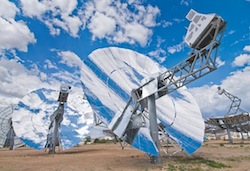Yesterday I brought you the story that the U.S. Department of Energy (DOE) announced a $10 million grant to develop concentrating solar power (CSP). As a follow-up, the DOE has announcement five more awards as part of its solar power innovation program SunShot Initiative that also supports research projects focused on lowering the cost of photovoltaic and concentrating solar power technologies.
The teams who received the award will collaboratively work together and work jointly with industry experts, universities and national laboratories to work together at the Department’s Scientific User Facilities, a national network of unique facilities that
 provide over 10,000 scientists and engineers each year with open access to some of the best instruments and tools in the world, including x-ray sources, accelerators, supercomputers and nanoscale research centers.
provide over 10,000 scientists and engineers each year with open access to some of the best instruments and tools in the world, including x-ray sources, accelerators, supercomputers and nanoscale research centers.
“The past decade has seen explosive growth in the global solar energy market. American companies are helping to lead this dramatic progress – driving lower costs and introducing new, better performing technologies into the marketplace. These collaborative projects announced today harness the immense capabilities of our Scientific User Facilities to invent and deploy new technologies that will strengthen American manufacturing and technical competitiveness,” said U.S. Energy Secretary Chu. “As part of President Obama’s all-of-the-above energy strategy, advanced solar energy technologies are helping to provide clean, renewable electricity for homes and businesses across the country while diversifying the United States’ energy economy.”
The five research projects selected fall under two levels: establishing scientific user facility research partnerships and developing a new scientific user facility instrument. Two projects were awarded a total of $900,000 in the first level and three projects were awarded $2.6 million.
PLANT PV will partner with Lawrence Berkeley National Laboratory’s Molecular Foundry to develop 3D mapping tools for higher performing thin film solar material. The University of Colorado will use tools available at Oak Ridge National Laboratory to research high-temperature inexpensive materials for concentrating solar power technologies.
Researchers from Sandia National Laboratories will partner with the Center for Integrated Nanotechnologies in New Mexico to improve the efficiency of thin film photovoltaic materials, while Arizona State University will use x-ray technologies at Argonne National Laboratory to address solar cell material performance. In addition, Stanford University will partner with SLAC National Accelerator Laboratory to research inexpensive ways to print solar cells.

